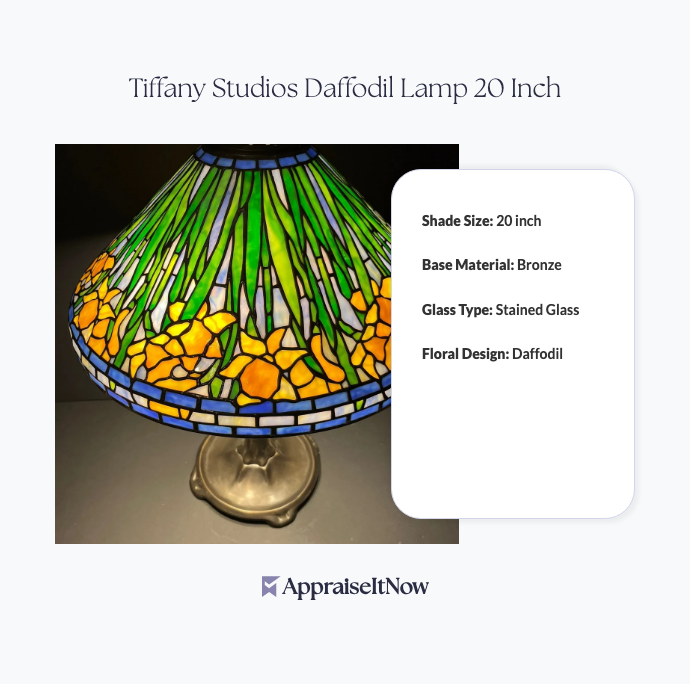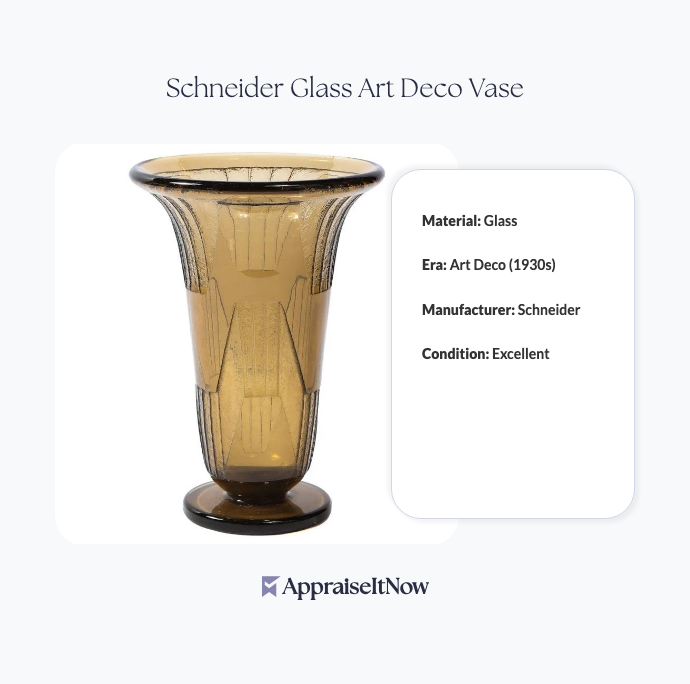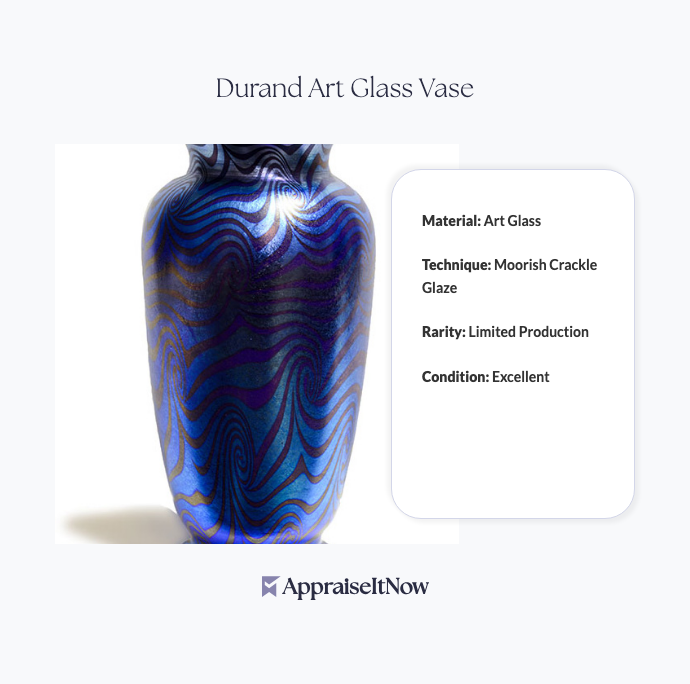<h1>How to Get Your Tiffany Studios Daffodil Lamp 20 Inch Appraised</h1>
<p>The Tiffany Studios Daffodil Lamp represents one of the most coveted pieces in the decorative arts market, with estimated values ranging from <strong>$18,000 to $24,000</strong> for authenticated 20-inch examples. Whether you've inherited this luminous masterpiece, discovered it at an estate sale, or are considering purchasing one, understanding the appraisal process and what drives its value is essential. A professional appraisal doesn't just confirm ownership—it provides the certified documentation you need for insurance, sale, estate planning, or collection management.</p>
<h2>Understanding Your Tiffany Studios Daffodil Lamp's Market Value</h2>
<p>The Tiffany Studios Daffodil Lamp commands significant collector interest due to its exceptional craftsmanship, historical significance, and rarity. First introduced in the early 1900s and handcrafted in New York by artisans working under Louis Comfort Tiffany's direction, each lamp represents hours of meticulous work. The 20-inch shade alone contains over 1,000 individually cut pieces of stained glass—primarily vibrant yellows, greens, and ambers—arranged to capture the delicate beauty of daffodil flowers in bloom.</p>
<p>What makes this lamp particularly valuable? Its bronze base, elegantly sculpted to complement the shade's organic design, represents the kind of thoughtful engineering that distinguished Tiffany Studios' output from imitators. The combination of limited production runs, superior materials, and the legacy of innovation associated with the Tiffany brand creates strong collector demand. When you're asking yourself "How much can I get for my Tiffany lamp?", the answer depends heavily on authentication, condition, and documented provenance.</p>
<div class="callout tip"><p><strong>Collector's Insight</strong></p>
<p>Authentic Tiffany Studios lamps with documented signatures and original components typically command 30-40% premiums over "Tiffany style" reproductions.</p></div>
<h2>Distinguishing Authentic Tiffany from Reproductions</h2>
<p>Before pursuing appraisal, understanding the critical difference between genuine Tiffany Studios pieces and later reproductions is fundamental. Many collectors ask, "How do I know if my lamp is worth money?" or "How to tell if you have a true Tiffany lamp?"—these distinctions directly impact value.</p>
<p>Authentic Tiffany Studios lamps display several hallmarks that appraisers verify. The glass quality shows variations in color and texture consistent with hand-cut techniques and period materials. The bronze base bears maker's marks, typically reading "TIFFANY STUDIOS NEW YORK" with a model number. The construction uses traditional copper foil or lead came techniques—you'll notice individual glass pieces have slightly irregular edges when examined under magnification. Reproductions, particularly modern "Dale Tiffany" style lamps or other contemporary interpretations, employ different materials, more uniform glass pieces, and mass-production methods.</p>
<p>This raises an important question many collectors have: "What's the difference between Tiffany and Dale Tiffany?" While Dale Tiffany produces quality reproductions and new works in the Tiffany tradition, they are explicitly modern pieces with different material composition, construction methods, and market values typically ranging from $300 to $3,000 depending on complexity. Authentic Tiffany Studios pieces, by contrast, are historical artifacts produced during the studio's operating period (approximately 1878-1938).</p>
<div class="callout note"><p><strong>Critical Distinction</strong></p>
<p>"Tiffany style" lamps are contemporary interpretations inspired by Tiffany's aesthetic, not original Tiffany Studios creations. This distinction is fundamental to appraisal value—understanding whether you have an authentic or reproduction piece determines the entire valuation approach.</p></div>
<h2>Key Features Appraisers Examine</h2>
<p>When you bring your Daffodil Lamp to a professional appraiser, they conduct a comprehensive technical evaluation that goes far beyond visual inspection. Understanding what appraisers assess helps you prepare documentation and appreciate your lamp's specific characteristics.</p>
<p>The shade receives primary scrutiny, as it contains the most identifying features and represents the highest value component. Appraisers examine glass color consistency, examining whether tones vary naturally as period glass does, or appear uniform as modern production suggests. The construction technique—whether the pieces are held with traditional lead came soldering or copper foil methods—reveals production era. They count and photograph glass segments, comparing the arrangement to documented Tiffany patterns. Original patina on the glass, including microscopic surface variations and oxidation patterns specific to age, provides authenticity confirmation.</p>
<p>The bronze base undergoes equally detailed inspection. Appraisers verify casting quality, checking for the irregularities and finishing characteristics of hand-crafted period pieces. They examine maker's marks for correct font, spacing, and depth consistent with Tiffany Studios' production methods. The patina—the oxidized surface layer—should show consistent aging throughout, with variation suggesting period use rather than artificial antiquing. They assess whether solder joints display appropriate period techniques and materials.</p>
<p>The internal construction, particularly the fitting that attaches shade to base, provides crucial dating and authentication clues. Original Tiffany lamps typically employed specific hardware configurations that changed over production years. Appraisers document whether electrical components are period-appropriate or later modifications, as original sockets, wiring, and switches all provide authentication evidence.</p>
<div class="callout tip"><p><strong>Preparation Insight</strong></p>
<p>Gather any original documentation, purchase receipts, family provenance records, or previous appraisals before your appraisal appointment. These materials significantly strengthen authentication and value determination.</p></div>
<h2>Condition Assessment and Value Impact</h2>
<p>The condition of your Tiffany Studios Daffodil Lamp directly influences its market value, with professional appraisers using standardized condition grades similar to those used in <a href="/blog/appraising-fine-art-a-comprehensive-guide-for-art-collectors-and-investors">fine art and antique artwork appraisals</a>. Understanding how condition affects pricing helps you assess whether restoration might be worthwhile.</p>
<p>Excellent condition examples—those with minimal glass losses, strong color saturation, secure solder joints, and patinated bronze showing even aging—command the upper range of the $18,000 to $24,000 valuation. Very good condition pieces may have minor glass repairs, slight solder line separation, or modest finish variations that reduce value by 10-15%. Good condition lamps with more significant restoration history, major glass replacements, or extensive bronze refinishing might value closer to $12,000 to $16,000. Pieces requiring major restoration may fall below $12,000 despite authenticity.</p>
<p>One critical consideration: should you restore your lamp before appraisal? Generally, professional appraisers recommend against major restoration before valuation, as pre-appraisal work obscures the original condition and authentication evidence. However, addressing obvious safety hazards—particularly with electrical components—is appropriate. The appraisal report will note condition issues and their impact on value, which then informs restoration decisions based on your specific goals.</p>
<h2>Finding the Right Appraiser for Your Tiffany Lamp</h2>
<p>Obtaining an accurate Tiffany Studios Daffodil Lamp appraisal requires more than general antique expertise. You need an appraiser with specific knowledge of Tiffany Studios' production history, recognized training in decorative arts valuation, and access to comparable sales data. AppraiseItNow connects you with credentialed appraisers—including AAA, ISA, ASA, CAGA, and AMEA certified professionals—who specialize in <a href="/blog/appraising-fine-glass-and-crystal-valuing-delicate-glassware-and-artistic-creations">fine glass and crystal valuations</a> and <a href="/blog/getting-started-with-antique-furniture-appraisal">antique furniture and decorative pieces</a>.</p>
<p>When selecting an appraiser, verify they hold relevant certifications in <a href="/blog/a-guide-to-professional-personal-property-appraisals">personal property appraisals</a> and have demonstrated experience with Tiffany lamps specifically. Ask about their access to recent comparable sales, their authentication methodology, and whether their reports meet USPAP standards—the industry requirement that ensures your appraisal documentation is accepted by insurance companies, courts, and financial institutions.</p>
<p>The appraiser should examine your lamp in person rather than relying on photographs alone. They'll inspect it thoroughly, potentially with magnification, to assess condition and authenticate construction details. They'll research comparable recent sales, consult their reference library of Tiffany patterns, and compile a detailed report documenting all findings with professional photography.</p>
<h2>Documentation and Appraisal Report Essentials</h2>
<p>A comprehensive appraisal report for your Tiffany Studios Daffodil Lamp should include several essential elements that give you confidence in the valuation and provide documentation acceptable for any professional purpose. The report identifies the item precisely—describing the 20-inch shade diameter, documenting glass color palette, noting the specific bronze base design, and confirming any maker's marks or signatures.</p>
<p>The appraiser should provide detailed condition notes, including photographs showing the shade from multiple angles, close-ups of construction techniques, maker's marks, and the bronze base from various perspectives. They'll document any repairs, replacements, or alterations, noting when these occurred if determinable. The condition assessment explains how condition factors affect value relative to pristine examples.</p>
<p>The market analysis section discusses comparable sales of similar Tiffany lamps, explaining current collector demand and market trends affecting your specific lamp. This section might reference recent auction results, private sales data, and current gallery listings, showing how these comparables support the concluded value. They should explain the reasoning behind the valuation—for instance, how authentication, condition, and market demand combine to place your lamp in the $18,000 to $24,000 range.</p>
<p>Finally, the report should specify the purpose and type of appraisal value—whether it's for insurance replacement value (what it would cost to replace), fair market value (what it would likely sell for), estate value, or other specific purposes. This clarity ensures the appraisal serves your intended use.</p>
<div class="callout note"><p><strong>Key Takeaway</strong></p>
<p>A professional USPAP-compliant appraisal of your Tiffany Studios Daffodil Lamp 20 Inch provides certified documentation essential for insurance protection, sale preparation, estate planning, or investment tracking, ensuring you understand both the historical significance and accurate market value of this exceptional decorative arts piece.</p></div>
<hr />
<p>Whether you're evaluating an inherited treasure, preparing for sale, or simply documenting your collection's value, obtaining a professional appraisal transforms your understanding of what you own. The Tiffany Studios Daffodil Lamp represents the intersection of artistic vision, technical mastery, and historical importance—a combination that commands respect and proper valuation. AppraiseItNow's network of credentialed appraisers brings specialized expertise to decorative arts valuation, providing the documented, professional assessment that stands up to any standard. Reach out today to connect with an expert who understands your lamp's unique value.</p>







.avif)







